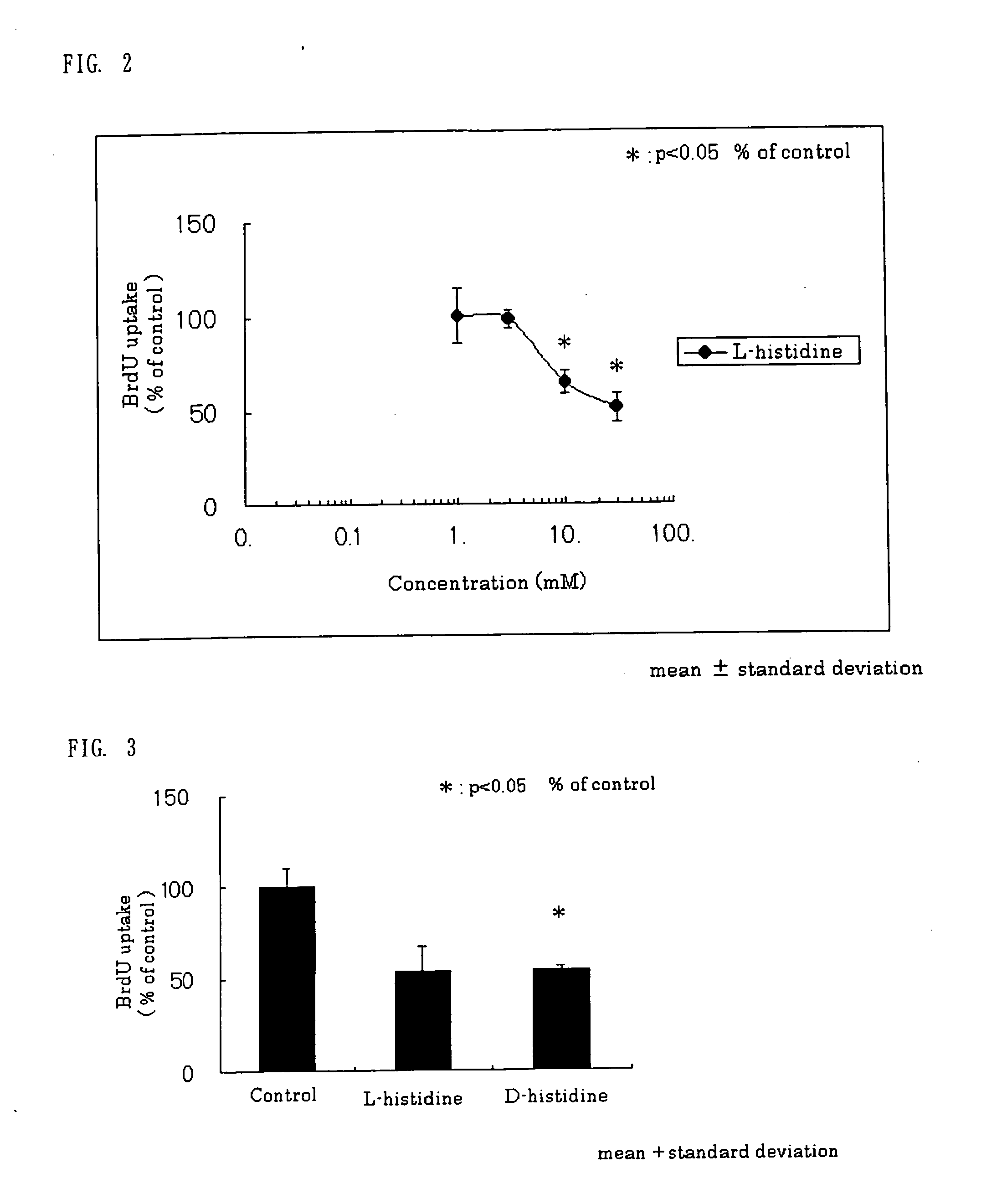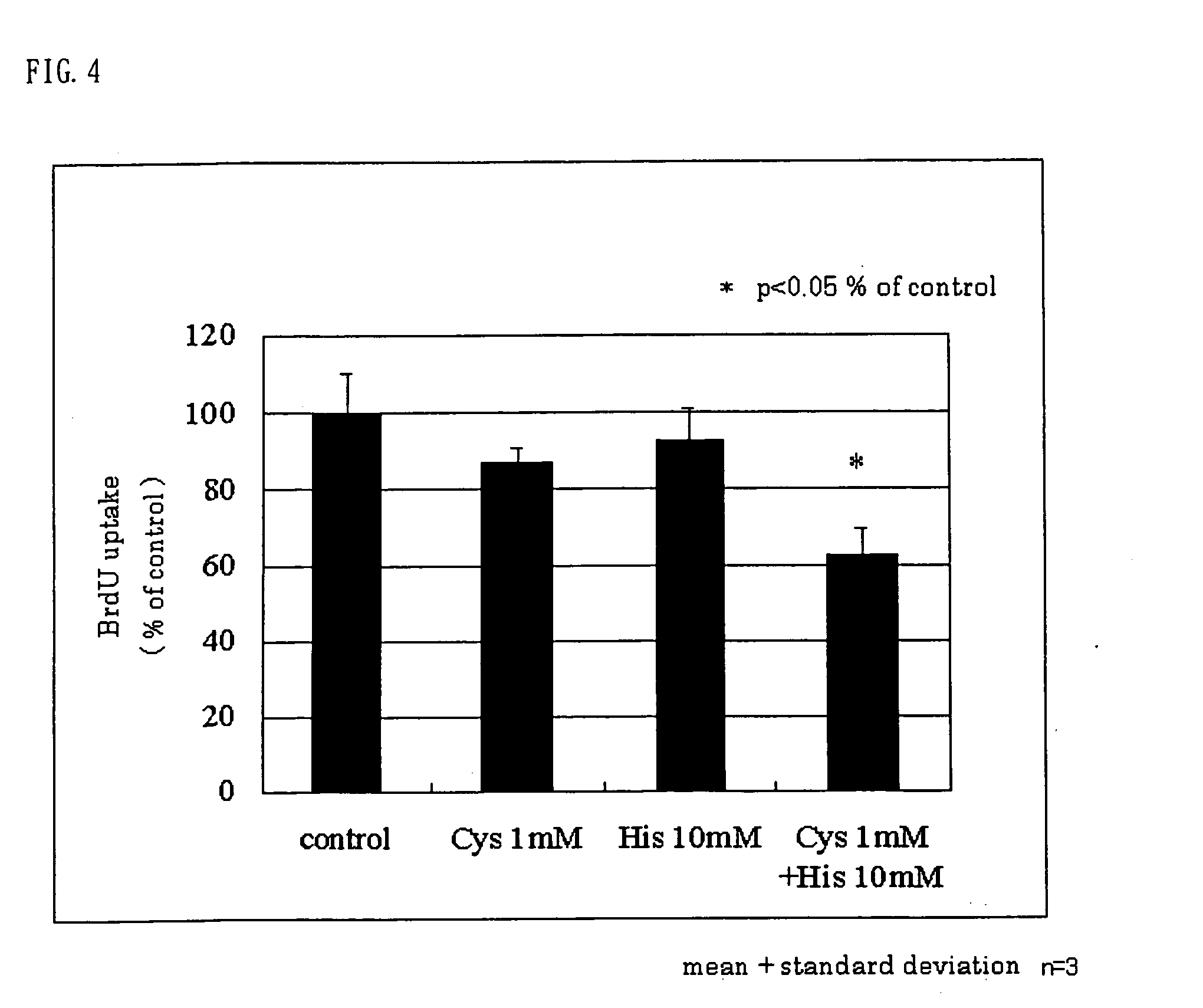Organ fibrosis inhibitor
a technology of organ fibrosis and inhibitors, applied in the field of organ fibrosis inhibitors, can solve the problems of organ fibrosis, no pharmaceutical agents (prophylactic, ameliorating and/or therapeutic agents) effective as organ fibrosis inhibitors, etc., and achieve the effect of suppressing organ fibrosis
- Summary
- Abstract
- Description
- Claims
- Application Information
AI Technical Summary
Benefits of technology
Problems solved by technology
Method used
Image
Examples
example 1
[0092] Dimethylnitroseamine (DMN) was administered intraperitoneally at 10 mg / kg three times weekly to a male 9-week-old SD rat for 3 weeks to induce liver fibrosis. A commercially available feed or experimental diets prepared by adding L-histidine (His) as a test substance at concentrations of 0.2, 0.5, 1.0, and 2.0 wt. % to a commercially available feed were fed beginning on the day of start of DMN administration and thereafter. On day 21 from the start of the DMN administration, the liver was collected to assay the amount of hydroxyproline (Hyp) in the liver as a liver fibrosis marker, using an amino acid analyzer. The results are shown in FIG. 1. As is clearly shown in FIG. 1, the amount of Hyp in the liver, which increased by about 6 fold via the DMN administration, was significantly decreased via oral His administration.
example 2
[0093] Hepatic stellate cells were isolated from a male Wistar rat liver and were cultured by the liver perfusion method with pronase E and collagenase. Hepatic stellate cells on day 8 to day 14 were cultured overnight in a culture medium containing 10 vol. % fetal calf serum (FCS). The culture medium was replaced with a culture medium containing 0.1 vol. % FCS, and it was cultured for 48 hours. Subsequently, L-histidine as the test substance was added in an amount to give a concentration of 1 to 30 mM. Then, further, platelet-derived growth factor (PDGF) was added to give a final concentration of 25 ng / ml, and the Hepatic stellate cells were cultured for 24 hours. Six hours before the completion of the culturing, bromodeoxyuridine (BrdU) was added to the culture system. After the completion of the culturing, the BrdU uptake into the cells was assayed by ELISA (enzyme-linked immunosorbent assay). As a control, only PDGF (at the final concentration of 25 ng / ml) was added to the cultu...
example 3
[0094] In the same manner as in Example 2, the effects of L-histidine and D-histidine (individually at 30 mM) on the DNA synthesis of Hepatic stellate cells were compared with each other. When the BrdU uptake in the control was defined as 100%, the value of each of the groups was calculated and is shown in FIG. 3. The results show that L-histidine and D-histidine both strongly suppressed the DNA synthesis of Hepatic stellate cells activated with PDGF, and the levels of the suppression were almost equal.
PUM
| Property | Measurement | Unit |
|---|---|---|
| molar ratio | aaaaa | aaaaa |
| weight | aaaaa | aaaaa |
| weight | aaaaa | aaaaa |
Abstract
Description
Claims
Application Information
 Login to View More
Login to View More - R&D
- Intellectual Property
- Life Sciences
- Materials
- Tech Scout
- Unparalleled Data Quality
- Higher Quality Content
- 60% Fewer Hallucinations
Browse by: Latest US Patents, China's latest patents, Technical Efficacy Thesaurus, Application Domain, Technology Topic, Popular Technical Reports.
© 2025 PatSnap. All rights reserved.Legal|Privacy policy|Modern Slavery Act Transparency Statement|Sitemap|About US| Contact US: help@patsnap.com



